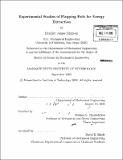| dc.contributor.advisor | Michael S. Triantafyllou. | en_US |
| dc.contributor.author | Simpson, Bradley James | en_US |
| dc.contributor.other | Massachusetts Institute of Technology. Dept. of Mechanical Engineering. | en_US |
| dc.date.accessioned | 2010-05-25T21:15:07Z | |
| dc.date.available | 2010-05-25T21:15:07Z | |
| dc.date.copyright | 2009 | en_US |
| dc.date.issued | 2009 | en_US |
| dc.identifier.uri | http://hdl.handle.net/1721.1/55283 | |
| dc.description | Thesis (S.M.)--Massachusetts Institute of Technology, Dept. of Mechanical Engineering, 2009. | en_US |
| dc.description | Cataloged from PDF version of thesis. | en_US |
| dc.description | Includes bibliographical references (p. 191-193). | en_US |
| dc.description.abstract | For centuries scientists have looked to nature for inspiration for novel and efficient solutions to engineering problems. Recently, research on fish and other marine mammals has shown their ability to efficiently extract energy from both steady and unsteady flows. Our research uses this previous work as motivation for experimentally examining the hydrodynamic performance of flapping foils to extract energy in a two-dimensional flow. We focused on identifying the effects that foil motion parameters had on the hydrodynamic energy extraction efficiency and resolving the wake structure downstream of the foil. The primary foil motion parameters investigated were the non-dimensional flapping frequency of the foil, the non-dimensional excursion amplitude of the foil, and the profile of the foil path during a typical energy extraction cycle. The heave and pitch of the fin was approximated by a NACA 0012 foil heaving and pitching sinusoidially 90° out of phase at a Reynolds number of 13,800. Energy extraction efficiencies of up to [eta] = 0.45 were found within a very small parametric region for small oscillation amplitudes while broad regions of appreciable efficiency were found at large oscillation amplitudes. The highest efficiency regions were all found to exhibit the same 2P vortex shedding mode. Further, the similitude between experiments for varying oscillation amplitude was not consistent when parameterized by the Strouhal number. This study shows parameterizing the flapping frequency by the reduced frequency results in vortex modes and efficiency contours aligning between varying oscillation amplitudes. | en_US |
| dc.description.statementofresponsibility | by Bradley James Simpson. | en_US |
| dc.format.extent | 193 p. | en_US |
| dc.language.iso | eng | en_US |
| dc.publisher | Massachusetts Institute of Technology | en_US |
| dc.rights | M.I.T. theses are protected by
copyright. They may be viewed from this source for any purpose, but
reproduction or distribution in any format is prohibited without written
permission. See provided URL for inquiries about permission. | en_US |
| dc.rights.uri | http://dspace.mit.edu/handle/1721.1/7582 | en_US |
| dc.subject | Mechanical Engineering. | en_US |
| dc.title | Experimental studies of flapping foils for energy extraction | en_US |
| dc.type | Thesis | en_US |
| dc.description.degree | S.M. | en_US |
| dc.contributor.department | Massachusetts Institute of Technology. Department of Mechanical Engineering | |
| dc.identifier.oclc | 613336258 | en_US |

